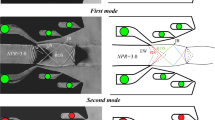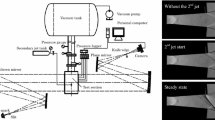Abstract
In this study, a comparison of five commonly used turbulence models was conducted in predictions of supersonic flows in a two-dimensional shock vector control nozzle. The result indicated that shear stress transport k−ω turbulence model performed best, and hence it was employed to carry out a parametric study on the shock wave vector control performance. The effects of slot interval distance, slot width, and injection angle on the deflection angle, thrust coefficient, and thrust efficiency were analyzed. All these performance parameters of a dual injection port nozzle can be better than those of a single injection port nozzle as long as the slot interval distance and width are appropriately selected. Under some investigated conditions, there exist an optimal slot interval distance and slot width both for the deflection angle and thrust efficiency, respectively.
Similar content being viewed by others
Change history
08 July 2022
An Erratum to this paper has been published: https://doi.org/10.1007/s12206-022-0652-3
References
K. A. Deere, Summary of fluidic thrust vectoring research conducted at NASA Langley Research Center, 21st Applied Aerodynamics Conference, Orlando (2003).
F. Xue et al., Research on control effectiveness of fluidic thrust vectoring, Science Progress, 104(1) (2021) 1–17.
M. S. Mason and W. J. Crowther, Fluidic thrust vectoring for low observable air vehicles, 2nd AIAA Flow Control Conference, Portland (2004).
P. I. A. Wilde et al., Aircraft control using fluidic maneuver effectors, 26th AIAA Applied Aerodynamics Conference, Honolulu (2008).
C. Tian and Y. Lu, Turbulence models of separated flow in shock wave thrust vector nozzle, Engineering Applications of Computational Fluid Mechanics, 7(2) (2013) 182–192.
R. Deng, F. Kong and H. D. Kim, Numerical simulation of fluidic thrust vectoring in an axisymmetric supersonic nozzle, Journal of Mechanical Science and Technology, 28(12) (2014) 4979–4987.
A. Balabel et al., Assessment of turbulence modeling for gas flow in two-dimensional convergent-divergent rocket nozzle, Applied Mathematical Modelling, 35(7) (2011) 3408–3422.
K. X. Wu, H. D. Kim and Y. Jin, Fluidic thrust vector control based on counter-flow concept, Proceedings of the Institution of Mechanical Engineers, 233(4) (2019) 1412–1422.
Z. Zhang et al., A RANS model correction on unphysical over-prediction of turbulent quantities across shock wave, International Journal of Heat and Mass Transfer, 106 (2017) 1107–1119.
L. Zhang et al., Numerical study of air flow induced by shock impact on an array of perforated plates, Entropy, 23(8) (2021) 1051.
K. A. Waithe and K. A. Deere, Experimental and computational investigation of multiple injection port in a convergent-divergent nozzle for fluidic thrust vectoring, 21st Applied Aerodynamics Conference, Orlando (2003).
M. Sellam et al., Assessment of gas thermodynamic characteristics on fluidic thrust vectoring performance: analytical, experimental and numerical study, International Journal of Heat and Fluid Flow, 53 (2015) 156–166.
K. X. Wu, T. H. Kim and H. D. Kim, Numerical study of fluidic thrust vector control using dual throat nozzle, Journal of Applied Fluid Mechanics, 14(1) (2021) 73–87.
J. L. Chen and Y. H. Liao, Parametric study on thrust vectoring with a secondary injection in a convergent-divergent nozzle, Journal of Aerospace Engineering, 33(4) (2020) 04020020.
H. J. Kowal, Advances in thrust vectoring and the application of flow control technology, Canadian Aeronautics and Space Journal, 48(2) (2002) 145–151.
V. Zmijanovic et al., Thrust shock vector control of an axisymmetric conical supersonic nozzle via secondary transverse gas injection, Shock Waves, 24(1) (2014) 97–111.
F. Forghany et al., Numerical investigation of injection angle effects on shock vector control performance, Proceedings of the Institution of Mechanical Engineers, 233(2) (2019) 405–417.
R. F. Cong et al., Numerical research on jet tab thrust vector nozzle aerodynamic characteristics, Journal of Physics Con ference Series, 1300 (2019) 012089.
K. Younes and J.-P. Hickey, Fluidic thrust shock-vectoring control: a sensitivity analysis, AIAA Journal, 58(4) (2020) 1887–1890.
C. C. Guo et al., Thrust control by fluidic injection in solid rocket motors, Journal of Propulsion and Power, 33(4) (2017) 815–829.
B. E. Launder and D. B. Spalding, Lectures in Mathematical Model of Turbulence, Academic Press, Cambridge (1972).
V. Yakhot and S. A. Orszag, Renormalization-group analysis of turbulence, Physical Review Letters, 57(14) (1986) 1722–1724.
T. H. Shih et al., A new K−ε eddy viscosity model for high Reynolds number turbulent flows, Computers and Fluids, 24(3) (1995) 227–238.
D. C. Wilcox, Turbulence Modeling for CFD, DCW Industries, Inc., La Canada (1998).
F. R. Menter, Two-equation eddy-viscosity turbulence models for engineering applications, AIAA Journal, 32(8) (1994) 1598–1605.
Acknowledgments
The authors are grateful to the financial support from the Natural Science Foundation of Zhejiang Province [grant no. LY17E060006], from the Fundamental Research Funds of Zhejiang Sci-Tech University [grant no. 2019Q030], and from the National Natural Science Foundation of China [grant no. 51876194, 52176048, U1909216].
Author information
Authors and Affiliations
Corresponding author
Additional information
Li-Te Zhang received his Ph.D. from Xi’an Jiaotong University, China, in 2007. Now he is an Associate Professor in Mechanical Engineering of Zhejiang Sci-Tech University, China. He is interested in the areas of dense particle-laden compressible gas flow, shock wave, and so on.
Hao-Zhe Jin received his Ph.D. from Zhejiang Sci-Tech University, China, in 2012. Now he is an Associate Professor in Mechanical Engineering of Zhejiang Sci-Tech University, China. He is interested in the areas of the multi-component fluid flow characteristics, gas-solid wear mechanism, and so on.
Rights and permissions
About this article
Cite this article
Zhang, L., Su, M., Feng, Z. et al. Numerical study on the shock vector control performance in a de Laval nozzle with single or dual injection ports. J Mech Sci Technol 36, 3001–3016 (2022). https://doi.org/10.1007/s12206-022-0532-9
Received:
Revised:
Accepted:
Published:
Issue Date:
DOI: https://doi.org/10.1007/s12206-022-0532-9




